Bulletin – June 2013 Global Economy Macroeconomic Management in China
- Download the article 198KB
Abstract
China's economy has expanded at a rapid pace over the past three decades, underpinned by a range of economic reforms. While many of these reforms have focused on the supply side of the economy, the authorities have employed a range of policies to manage aggregate demand and control the build-up of inflationary pressures and financial risks. The operation of macroeconomic policy in China differs from that typically used in developed economies, reflecting China's particular institutional and economic environment. Macroeconomic policy is implemented in a coordinated manner with authorities using a range of monetary, fiscal and regulatory policy instruments to achieve economic objectives.
Introduction
The Chinese economy has expanded rapidly over the past three decades, with annual growth averaging around 10 per cent per annum. This has been underpinned by a range of economic reforms that have made the economy more market oriented and encouraged growth of the productive capacity of the economy. The initial reforms freed up agricultural production; subsequent reforms extended to rationalisation of the state-owned industrial sector, property ownership and the gradual opening up of the economy to international trade and investment, including accession to the World Trade Organization in 2001. While these reforms have had a supply-side focus, policymakers have nevertheless needed to employ a range of policies to manage aggregate demand.
A central aim of macroeconomic demand management has been to support economic growth, while also responding to fluctuations in global and domestic business conditions in order to sustain domestic employment and prevent an excessive build-up in inflationary pressures or financial risks. As in other economies, Chinese policymakers employ a range of monetary, fiscal and regulatory policy instruments to manage aggregate demand. However, the operation of macroeconomic policy differs in a number of significant ways from that in most developed economies, owing to differences in institutional characteristics and the stage of development of the Chinese economy.
Compared with the typical arrangements in developed economies, Chinese monetary and fiscal policy are tightly coordinated by the central government. Moreover, in the area of monetary policy, the managed float exchange rate regime relies on significant restrictions on capital flows, and the relative dominance of banks in the financial sector means that monetary policy can be largely implemented through a range of regulatory instruments. Nonetheless, as the Chinese economy has developed, there has been a gradual evolution towards the use of market-based policy instruments like those used in more developed economies. The Chinese Government has signalled its intention for this evolution to continue in line with developments in the economy and financial markets in particular.
This article provides an overview of the operation and evolution of macroeconomic policy in China over the past decade. It begins with a discussion of the institutional and economic environment in which demand management policies operate, and then describes the performance of the Chinese economy in terms of macroeconomic growth and inflation outcomes over the past decade, before outlining the operation of monetary, fiscal and property market policies.
Institutional Environment and Objectives of Policy
Chinese national economic policy is determined by the State Council, which sets out the five-year plans containing the government's broad long-term economic agenda, including targets for urbanisation, industrialisation and gradual market liberalisation. Recent five-year plans have also provided medium-term targets that lay down the path to achieving the longer-term objectives. Some examples from the Twelfth Five-year Plan in 2010 include targets for the service industry share of GDP, education completion rates, and reforms to the financial sector which are expected to be achieved by 2015.[1] While the State Council determines the overall objectives of policy, implementation is the responsibility of both local and central government agencies.
Within the context of the five-year plans, the State Council also sets annual goals for macroeconomic outcomes. Targets for inflation and growth in the money supply and in GDP are announced at the annual meeting of the National People's Congress; the 2013 targets for these are 3.5, 13 and 7.5 per cent per annum, respectively. The central budget is also announced at this meeting. Thus, the general stance of macroeconomic policy, as summarised by the budgetary stance and the targets for growth in money supply, is set in a coordinated manner in the context of the State Council's longer-term economic objectives. Over the past decade, GDP growth has exceeded the targets set by the State Council, while consumer price inflation has both overshot and undershot the targets. The targets for inflation in particular are often adjusted annually reflecting the State Council's assessment of what is an acceptable trade-off between growth and inflation in response to the experience of the most recent year. Unlike the inflation targets in most inflation-targeting monetary policy systems, the Chinese target is not a fixed objective but a guide that is adjusted as conditions evolve.
The State Council is also responsible for setting the broad stance of other policies that have an influence on macroeconomic management – the most important of these being the managed float exchange rate regime. The objective of exchange rate policy has been to encourage industrialisation and development of the export sector by insulating the economy from exchange rate volatility. Prior to 2005, the Chinese currency was fixed against the US dollar. Since 2005, the currency has been managed in a way that has allowed gradual adjustment, as the authorities have attempted to gradually move towards a more market-determined exchange rate regime (see Ballantyne, Garner and Wright (2013)).
Other State Council policies that are often intended to have macroeconomic effects include several direct controls on particular sectors of the economy. The State Council promotes the development of certain industries and moderates growth in others to help achieve a range of economic, environmental and social outcomes considered necessary for sustainable development in the long term. The most notable example is the property market, where property price inflation and construction activity have important implications for macroeconomic and financial stability, and where the government is active in affecting both the supply and demand for housing.
A range of institutions are responsible for the implementation of macroeconomic policies. Exchange rate policy is implemented by the People's Bank of China (PBC) and the State Administration of Foreign Exchange (SAFE) (IMF 2012). The managed float exchange rate regime has necessitated regulatory controls over foreign capital flows in order to provide some leverage over domestic money supply. In the absence of capital controls, it would not be possible to control both the exchange rate and domestic money supply. Within this framework, the PBC implements domestic monetary policy using a range of tools in order to control domestic money and credit growth. These include benchmark interest rates on loans and deposits, variations in reserve requirement ratios for banks, open market operations and direct influence over bank lending (referred to as ‘window guidance’).
Fiscal and other regulatory policies are implemented by a broad range of central and local government agencies. While the majority of public revenue is collected by the central government, most government expenditure is undertaken at the local level. This is particularly the case for social security, education and infrastructure spending. Although local governments are typically responsible for undertaking infrastructure projects, the National Development and Reform Commission (NDRC) plays an important role in the implementation of this aspect of fiscal policy by providing central oversight of major investment projects. The relatively large size of infrastructure and other public investment spending as a share of the Chinese economy has meant this component of fiscal policy has been an important element of macroeconomic management, in addition to its importance in expanding the supply side of the economy.[2] The complete impact of China's fiscal policy is not reflected in the consolidated local and central government budget position, since the government also relies on its ability to influence the investment activities of state-owned enterprises to achieve policy objectives.
An important feature of macroeconomic policy implementation in China is that fiscal and monetary policies are implemented in a highly coordinated way, with the overall direction of policy set by the State Council. This is in contrast to the trend in developed economies, over recent decades, towards greater independence of central banks from fiscal authorities. An example of this coordination in the Chinese system is where the government implements fiscal policy through its influence over the investment activities of state-owned enterprises and local governments, which are supported by the credit policy actions of the PBC that ensure the Chinese banking system provides the necessary funding. This coordination was particularly evident during the global financial crisis, when state-owned banks lent to state-owned enterprises in industries that the government was seeking to stimulate.[3] This episode also demonstrated how policy authorities in China are able to respond, when necessary, to changing circumstances in a timely manner, notwithstanding the institutional structures that underpin the five-year plans and annual targets.
Recent Cycles in Growth and Inflation
China's economy has experienced noticeable cycles in growth and inflation over the past decade (Graph 1). Fluctuations in demand have reflected developments in the global business cycle and policy responses to emerging domestic imbalances. Following the reforms of the 1990s and the early 2000s, GDP growth picked up, averaging more than 10 per cent per annum over the five years to 2008. In the latter part of that period, a combination of strong global demand and a relatively stable exchange rate saw rapid growth in external demand, with net exports making a significant contribution to growth (Graph 2). During the global financial crisis, growth slowed sharply as external demand weakened and net exports subtracted from growth. With the implementation of the Chinese coordinated stimulus, growth recovered through to 2009 with a surge in investment activity, and was around 10 per cent in 2010. More recently, growth has been steady at a more moderate pace. The recent lowering of the growth target reflects the widely held view that trend growth will gradually slow as the economy develops further.[4] Over the longer term, China's potential growth rate is expected to ease as the pace of labour and capital accumulation slows.
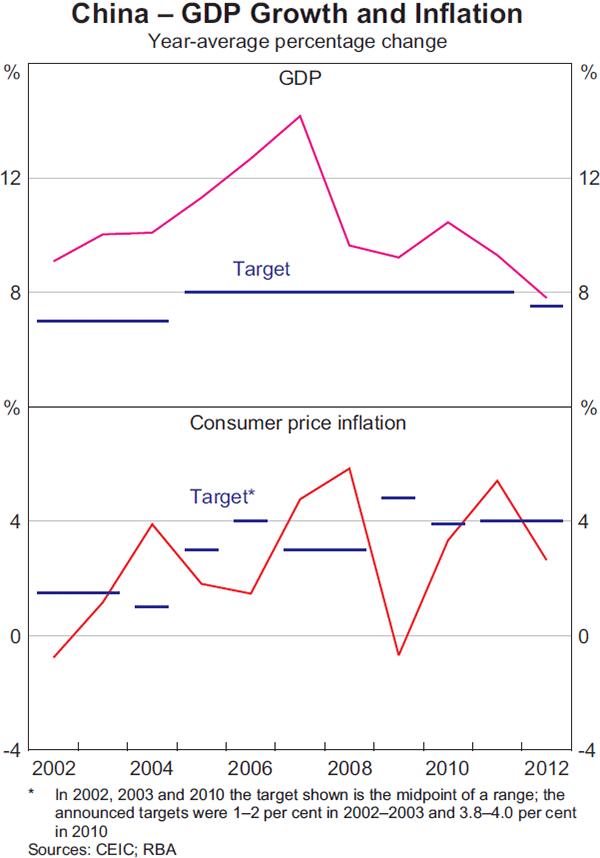
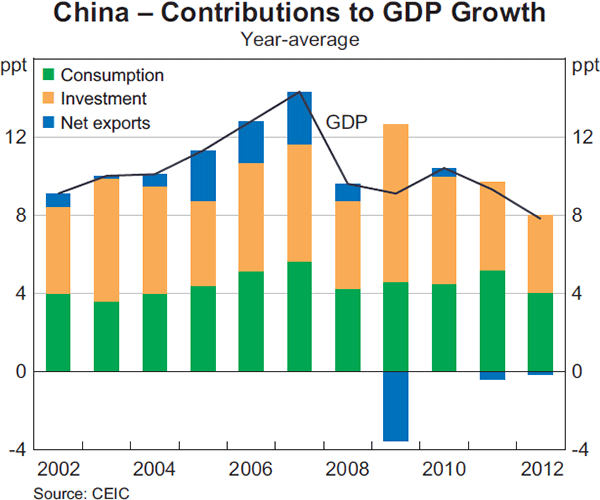
Since 2000, China has achieved an average annual growth rate of 10 per cent. This has supported solid growth in urban employment of over 4 per cent per year on average, which is an important priority of the government. The available annual data on employment suggest that fluctuations in employment growth have been relatively muted, with employment growth easing to only around 3¾ per cent during the crisis years of 2008 and 2009, and slowing to a decade low of around 3¼ per cent in 2012.[5] Consumer price inflation has undergone three cycles over the past decade, with adverse food supply shocks, movements in commodity prices as well as fluctuations in aggregate demand affecting inflation outcomes. Notwithstanding these fluctuations, average inflation over the period has been relatively low at around 4 per cent, indicating that overall demand management has been consistent with the expansion in the economy's supply capacity. These macroeconomic outcomes compare well with the economic performance of both emerging and developed economies over the same period.[6]
Monetary Policy
The PBC seeks to meet the growth and inflation targets set by the State Council through its control of the exchange rate and influence over domestic money supply and credit growth in the economy. Following the move from a fixed to a managed float exchange rate regime in 2005, the PBC has allowed the renminbi (RMB) to gradually appreciate, except for a pause for two years from mid 2008. This pause was in response to the global financial crisis, which saw demand for Chinese exports decline sharply (Graph 3).[7] Since the shift to the managed float regime, the currency has appreciated by around 30–35 per cent against the US dollar and on a real effective basis.
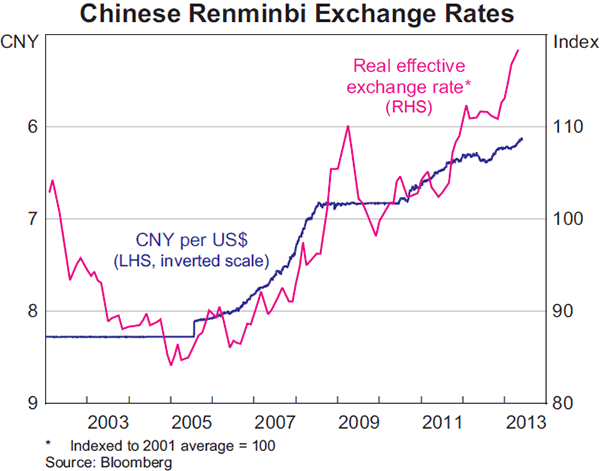
Although a managed float exchange rate regime implies that the domestic money supply is driven by developments in the current account, the use of tight capital controls in China provides the PBC with the capacity to ‘sterilise’ the effect of balance of payment flows on the domestic money supply. Moreover, given the dominance of the regulated banking sector in China's overall financial system, the PBC's control of a range of regulatory and market instruments that influence banks' funding and loan creation has enabled it to assert considerable influence on the amount of money and credit in the economy and therefore macroeconomic outcomes.
Like other central banks, the PBC monitors economic and financial conditions continuously to assess the need for adjustments in the stance of policy; however, the PBC does not have a fixed timetable for policy announcements.[8] The instruments used by the PBC to adjust the overall stance of policy include: benchmark interest rates on bank loans and deposits; banks' reserve requirements; open market operations; and window guidance on banks' credit creation activities. This is different from the way that monetary policy is implemented in most developed economies, where typically the short-term interest rate is the key policy instrument.[9] One implication of the breadth of policy instruments employed by the PBC is that it is not possible to summarise changes in the stance of policy by considering only a single instrument. The overall stance of policy is determined by the combination of instrument settings, with the mix of policy instruments at any one time depending on the PBC's assessment of which instruments will be most effective in achieving the desired financial conditions.
The PBC directly sets benchmark interest rates on Chinese banks' deposits and loans, with the benchmarks differentiated by the term of the deposit or loan (Graph 4). The benchmark rates are a significant determinant of actual deposit and loan rates and so influence both the supply of bank deposits and the demand for bank loans. Benchmark rates previously set a ceiling on deposit rates and a floor on loan rates, although there were exceptions to these rates. Recent reforms have eased these restrictions by allowing banks to pay up to 1.1 times the relevant benchmark rate on deposits, and charge lending rates as low as 0.7 times the benchmark (PBC 2012).[10] Benchmark interest rates influence the rates faced by businesses and households, though many actual lending rates exceed the benchmark, with the spread to benchmark lending rates influenced by a range of factors including the risk profile of borrowers and the general availability of funds in the market.
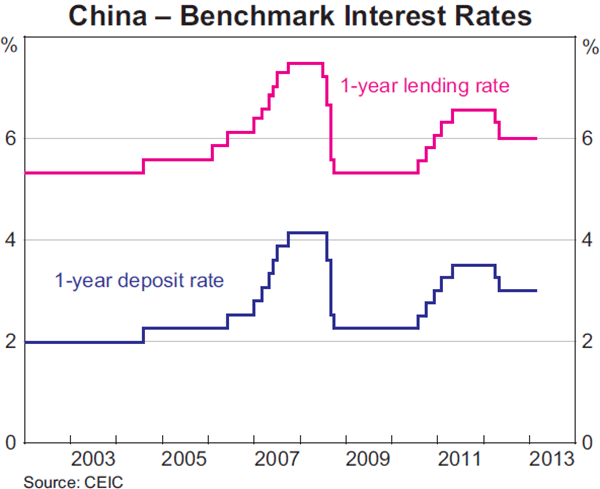
The transmission of changes in benchmark interest rates to economic activity is influenced by the structure of Chinese banks' balance sheets, which are reliant on household deposits while lending is predominately to businesses. Chinese households are net savers and have low leverage; this may reflect limited access to alternative investment opportunities outside of deposits and the purchase of real estate, coupled with a precautionary savings motive (Nabar 2011). Low benchmark deposit rates have meant that many households have been receiving interest rates that have been below the rate of inflation on their savings. Due to their large pool of savings, Chinese households have had a lower tendency to borrow and the flow of bank lending to businesses exceeds that to households (Graph 5). The banking system appears to be gradually changing as financial institutions, such as trust companies, have emerged offering wealth management products that pay higher interest rates than bank deposits. This may lead to further evolution of how monetary policy is implemented, by raising the importance of instruments affecting market interest rates directly, relative to those based on the PBC's regulatory control over bank interest rates and lending.
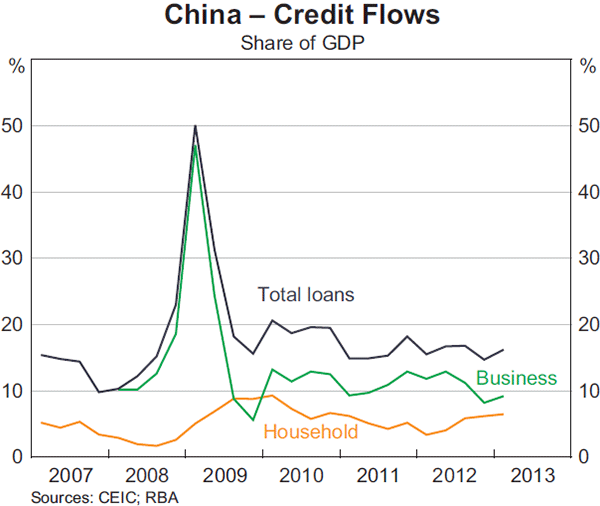
The PBC's ability to directly influence the quantity and type of lending is strengthened by its window guidance activities, where it advises banks on how much and to which industries they should be lending. Although formal credit quotas were abolished in 1998, the PBC continues to maintain considerable input into the decisions about the quantity and composition of bank lending (PBC 2002). In part, window guidance has a macroeconomic policy objective, such as supporting the fiscal stimulus during the global financial crisis period. They are also designed to reinforce microeconomic industry policy, such as the government's support for the agricultural sector during the early 2000s and, more recently, providing support for the small and medium-sized enterprise sector.
Another important instrument is the reserve requirement ratio (RRR), which determines the proportion of deposit liabilities that the PBC requires banks to hold as assets at the central bank. By varying RRRs, the PBC is able to affect the supply of funds available for lending in the economy, which can influence the growth in credit. The PBC introduced RRRs in the mid 1980s, although changes to RRRs were initially infrequent: between their establishment in 1984 and 2005, RRRs were adjusted only eight times (Ma, Xiandong and Xi 2011). Since 2006, the PBC has used RRRs as an active tool of monetary policy (Graph 6).[11] One reason for this has been the pick-up in foreign exchange inflows. Under its managed float exchange rate policy, the PBC has often been required to purchase foreign exchange inflows in order to keep the exchange rate within its daily trading band.[12] These foreign exchange purchases have needed to be sterilised to prevent an expansion of the domestic money supply and an overshoot of the money growth target. Increases in RRRs have played a key role in withdrawing the excess liquidity resulting from foreign exchange purchases from the banking system, as can be seen by the dominance of reserves on the liabilities side of the PBC balance sheet (Graph 7).
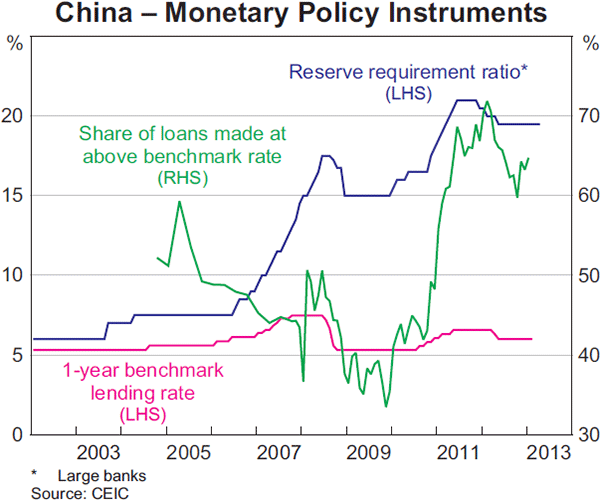
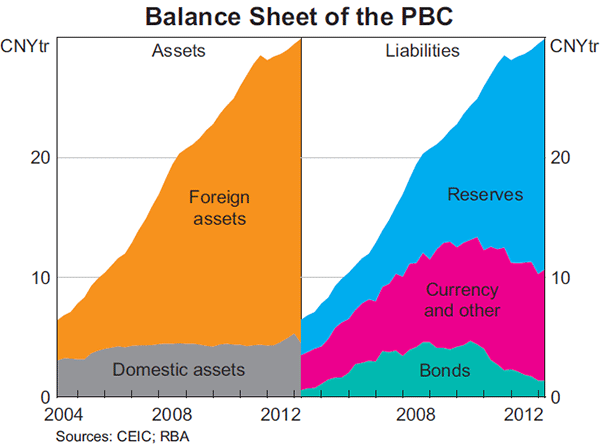
At the same time, RRRs have played a role in enhancing the effect of changes in benchmark rates on domestic credit conditions. For example, increases in RRRs in 2011 were associated with a spike in the share of loans made at above benchmark rates, with this effect unwinding somewhat in 2012 when RRRs were eased.
In addition to adjustments to regulated benchmark interest rates and RRRs, the PBC also uses open market operations to influence the availability of liquidity in the banking system. Prior to the global financial crisis, the PBC issued bonds that, along with adjustments in the RRRs, helped to sterilise foreign exchange inflows. In recent years, with slower foreign exchange inflows, outright bond issuance has been limited, but the PBC has been more active in using repurchase agreements (repos) and reverse repurchase agreements to influence liquidity conditions in the banking sector. These transactions are similar in nature to those used to implement monetary policy in many developed economies, including Australia. However, in China these operations are currently used only for higher frequency ‘finetuning’ of liquidity conditions as the relevant markets are not sufficiently established for this to be the primary tool for monetary policy implementation. Substantial adjustments in the stance of policy at this stage are still likely to require adjustments in benchmark interest rates and/or RRRs.
As the Chinese financial system continues to evolve there is likely to be an increasing reliance on open market operations in the implementation of monetary policy. The government's current five-year plan for financial sector development emphasises market-based reforms and the recent rapid growth in non-bank components of total social financing (TSF) indicates that the dominance of the regulated banking sector in the Chinese economy will lessen over time (PBC et al 2010). As this proceeds, the effectiveness of monetary policy instruments that act only on financial institutions' regulated banking activities will be diminished; at the same time a deepening of domestic financial markets will improve the potency of market-based policy instruments.
Fiscal Policy
Fiscal policy is implemented by a range of central and local government agencies. While the State Council is again responsible for the overall direction of policy, much of the responsibility for implementation resides with local governments, which account for a large proportion of government expenditure, including social security, education and infrastructure investment.
Investment by local governments is financed through a combination of central government transfers, local revenues and borrowing. Local governments are subject to restrictions on direct borrowing, which has led to the creation of local government financing vehicles (LGFVs) that raise funds on their behalf. Local governments raise funds though LGFVs to finance public infrastructure projects. As a result, spending by local governments, and the impact of fiscal policy, is not fully reflected in the consolidated local and central government budget position.
The budget balance nevertheless provides a useful guide to the changes in the stance of fiscal policy. The consolidated local and central government budget shows that the general government sector ran a budget deficit in the early 2000s (Graph 8). Then, as economic growth picked up, the budget balance moved from a deficit of around 2.5 per cent of GDP in 2002, to a surplus of around 0.5 per cent in 2007. In response to the global financial crisis, the central government announced a CNY 4 trillion stimulus package in the December quarter of 2008 to be spent over the following two years. This was equivalent to about 6.7 per cent of GDP in each year (OECD 2010), although only part of this was reflected in the consolidated budget, with a significant proportion also financed by local governments through LGFVs.
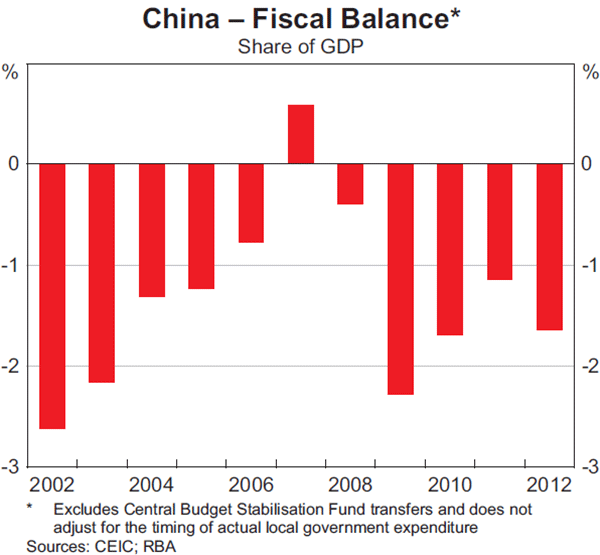
The stimulus package was directed largely at infrastructure projects executed by local governments, with the focus in the early stages of implementation on smaller projects that could be executed quickly. Around CNY 1 trillion of the expenditure was allocated to reconstruction in areas damaged by the Sichuan earthquake of May 2008. At the same time, and reflecting the close coordination between fiscal and monetary policy, the increase in expenditure was accompanied by an expansion of bank lending, particularly to state-owned enterprises and LGFVs.
When economic growth recovered in the years following the global financial crisis, the budget deficit correspondingly contracted to 1.1 per cent in 2011. More recently, economic growth has slowed; and fiscal policy appears to have been moderately expansionary in 2012 and government estimates suggesting that fiscal policy will again be mildly expansionary in 2013.[13] The shift to a moderately expansionary fiscal policy has been evident in the pick-up in growth in infrastructure investment over the second half of 2012. Notably, on this occasion, the authorities have not eased monetary policy settings, reflecting the PBC's assessment that policy needs to remain prudent given concerns over the lingering effects of the crisis period on asset quality in the banking sector.
Borrowings by LGFVs increased significantly during the global financial crisis and led to concerns about the quality of banking sector assets. After a National Audit Office report in 2010 highlighted the size of local government debt, the CBRC has stepped up its monitoring of, and implemented controls on, lending to LGFVs; these have been strengthened further in 2013. Although the risks associated with the quality of lending during the stimulus period of 2009–2010 is a downside risk to the outlook for the economy, policy flexibility is not as constrained as in many of the North Atlantic economies most affected by the crisis.
Property Market
The property market is an important driver of economic activity in China, with the property investment cycle contributing to fluctuations in aggregate demand. As part of the urbanisation process, the housing stock has needed to be expanded and its quality upgraded. Property construction affects industrial production through demand for materials such as concrete, steel products and glass. The property market remains a significant destination for household saving, as China's financial markets are not sufficiently developed to offer the range of alternative investment opportunities typically available in developed economies.
In the lead-up to the global financial crisis, residential property prices were rising rapidly. However, the onset of the global financial crisis led to a sharp fall in activity and property price inflation. With growth in overall economic activity slowing rapidly, the authorities acted to stimulate the property sector with several measures, including: reducing down-payment requirements on the purchase of properties; lowering minimum mortgage interest rates; and lowering the minimum holding period for a property to qualify for an exemption from capital gains tax (RBA 2012). These policy changes had the desired effect, with both turnover and property prices increasing significantly in 2009 and early 2010 (Graph 9).
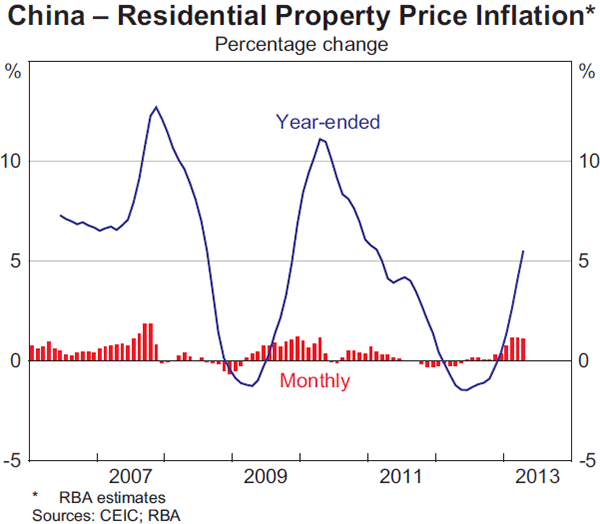
With property prices continuing to rise at a fast pace through to early 2010, authorities shifted the policy focus to preventing property prices from growing too rapidly. While this is likely to have been motivated largely by the desire to avoid overheating in the property market and the economy more broadly, there were also concerns about the affordability of housing. Authorities addressed this by introducing a number of property market restrictions targeted at curbing speculative and investor demand, while simultaneously introducing measures to increase the supply of affordable housing. Growth in transaction volumes eased in 2010 as a whole, after having risen sharply in 2009, and property price inflation slowed until mid 2012.
Although property controls have remained in place, property price inflation has once again begun to pick up from early 2013. This has led to the announcement of additional property market controls, as well as renewed efforts to enforce previously announced controls. It appears that these announcements have recently brought forward sales, as property owners attempt to avoid the new restrictions and additional taxes. Overall, while demand-side property controls have at times been effective in temporarily curtailing price appreciation, these policies are unlikely to be effective in the long run unless housing supply is able to keep up with rapid growth in underlying demand.
Conclusion
Over the past decade, Chinese authorities have used macroeconomic policies to support economic growth and to promote the longer-term policy objectives of industrialisation and urbanisation while also managing financial and inflationary pressures. To manage aggregate demand growth, monetary and fiscal policy, together with controls on the property market, have been used in a coordinated manner to respond to external shocks and domestic developments. The coordinated nature of macroeconomic management was most evident in the combined monetary and fiscal stimulus in response to the collapse in external demand associated with the global financial crisis. Adjustments to the stance of macroeconomic policy have been implemented using a range of tools, which has included managing the appreciation of the exchange rate and regulatory control of bank lending (through benchmark interest rates, reserve requirements and window guidance). However, reflecting the evolution of the Chinese economy, there has also been a gradual development of market-based policy instruments. As the Chinese economy becomes increasingly market based and open, the reliance on market-based instruments to manage the economy is expected to increase in future (Hu 2010). More generally, the Chinese authorities have emphasised the goal of sustainable growth. One aspect of this is that, with some concerns about the build-up of debt in recent years, including that associated with the stimulus in the global financial crisis, the room for proactive macroeconomic policy is more limited than in the past. In addition, the target for growth has been lowered, consistent with a slowing in potential growth as the economy reaches a more advanced stage of economic development following very rapid growth over the past three decades.
Footnotes
The authors completed this work in Economic Group. [*]
For further information on financial sector goals, see PBC, CBRC, CSRC, CIRC and SAFE (2010). [1]
The majority of infrastructure fixed asset investment is undertaken by the government, and accounts for over 20 per cent of total fixed asset investment. Since investment accounts for around 50 per cent of GDP, it is a significant contributor to economic growth. Fixed Asset Investment (FAI) differs from Gross Fixed Capital Formation (GFCF), which is the national accounts measure of investment. [2]
In addition to acting in concert with the fiscal authorities to respond to cyclical variations in growth and inflation, the PBC also contributes to the government's structural objectives by influencing the direction of credit flows in accordance with the government's industry policy. [3]
Chinese Premier, Wen Jiabao, explained that in setting the GDP growth target for 2013 at 7.5 per cent, policymakers must ensure that ‘economic growth is in accord with the potential economic growth rate, the ability to supply factors of production, and the bearing capacity of resources and the environment’ (Wen 2013). [4]
See Rush (2012) for a discussion of long-term trends in the Chinese labour market. [5]
China has grown faster and with lower average inflation than its fast-growing emerging economy peers (Russia, Brazil, India and South Africa). Moreover, while Chinese inflation has been more variable than in the slow-growing developed economies, average inflation has only been moderately higher. [6]
See Ballantyne, Garner and Wright (2013) for a discussion of recent developments in regulation of RMB trading. [7]
The PBC publishes a Quarterly Monetary Policy report; see PBC (2012). [8]
Since the crisis, a number of developed economies have reached the zero lower bound on the short-term interest rates used as the instrument of monetary policy and have been implementing monetary policy through quantitative measures such as asset purchases designed to influence other interest rates in the economy. [9]
These reforms were announced in June 2012, when the PBC cut benchmark interest rates. [10]
Since 2011, the PBC has set ‘dynamic differentiated’ reserve requirement ratios for individual banks. These were introduced to allow the PBC to have different reserve requirements for individual banks and to adjust these over time based on a range of criteria, such as the industry breakdown of their loans or financial stability considerations (Turner, Tan and Sadeghian 2012). [11]
The PBC manages the exchange rate by setting a daily fixing rate and allowing fluctuations within a defined band. The trading band was widened in 2007 and again in 2012 to its current setting. [12]
The shift in the budget position will reflect both the operation of automatic stabilisers and active spending decisions. [13]
References
Ballantyne A, M Garner and M Wright (2013), ‘Developments in Renminbi Internationalisation’, RBA Bulletin, June, pp 65–74.
Hu X (2010), ‘Exchange Rate Regime Reform and Monetary Policy Effectiveness’, Speech, 26 July. Available at <http://www.pbc.gov.cn/publish/english/956/2010/20100804100116452770088/20100804100116452770088_.html>.
IMF (International Monetary Fund) (2012), Country Chapter: People's Republic of China, in Annual Report on Exchange Rate Arrangements 2012, International Monetary Fund, Washington DC. Available at <http://www.imfareaer.org/Areaer/Pages/Reports.aspx>.
Wen J (2013), ‘Report on the Work of the Government’, Address to the First Session of the Twelfth National People's Congress, Beijing, 5 March. Available at <http://news.xinhuanet.com/english/china/2013-03/18/c_132242798.htm>.
Ma G, Y Xiandong and L Xi (2011), ‘China's Evolving Reserve Requirements’, BIS Working Paper No 360.
Nabar M (2011), ‘Targets, Interest Rates, and Household Saving in Urban China’, IMF Working paper WP/11/223.
OECD (Organisation for Economic Co-operation and Development) (2010), Economic Survey of China 2010, OECD Economic surveys and country surveillance.
PBC (People's Bank of China) (2002), ‘Analysis Report on Sound Monetary Policy’, 26 February. Available at <http://www.pbc.gov.cn/publish/english/955/2009/20091215155610511671701/20091215155610511671701_.html>.
PBC (2012), China Monetary Policy Report, Quarter Two, pp 10–11.
PBC, CBRC, CSRC, CIRC and SAFE (Peoples Bank of China, China Banking Regulatory Commission, China Securities Regulatory Commission, China Insurance Regulatory Commission and State Administration of Foreign Exchange) (2010), ‘The 12th Five-year Plan for the Development and Reform of the Financial Industry’. Available at <http://www.csrc.gov.cn/pub/csrc_en/newsfacts/release/201210/W020121010631355001488.pdf>.
RBA (Reserve Bank of Australia) (2012), ‘Box A: China's Residential Property Market’, Statement on Monetary Policy, February, pp 14–16.
Rush A (2011), ‘China's Labour Market’, RBA Bulletin, September, pp 29–38.
Turner G, N Tan and D Sadeghian (2012), ‘The Chinese Banking System’, RBA Bulletin, September, pp 53–63.